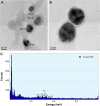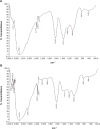Biosynthesis characterization of silver nanoparticles using Cassia roxburghii DC. aqueous extract, and coated on cotton cloth for effective antibacterial activity
- PMID: 26491310
- PMCID: PMC4599608
- DOI: 10.2147/IJN.S79984
Biosynthesis characterization of silver nanoparticles using Cassia roxburghii DC. aqueous extract, and coated on cotton cloth for effective antibacterial activity
Abstract
The present study reports the green synthesis of silver nanoparticles (AgNPs) from silver precursor using a plant biomaterial, Cassia roxburghii DC., aqueous extract. The AgNPs were synthesized from the shade-dried leaf extract and assessed for their stability; they elucidated characteristics under UV-visible spectroscopy, X-ray diffraction, Fourier transform infrared spectroscopy, high-resolution transmission electron microscopy, and energy dispersive X-ray spectroscopy. The synthesized AgNPs exhibited a maximum absorption at 430 nm, and the X-ray diffraction patterns showed that they were crystal in nature. Fourier transform infrared spectroscopy analysis confirmed the conversion of Ag+ ions to AgNPs due to the reduction by capping material of plant extract. The HR-TEM analysis revealed that they are spherical ranging from 10 nm to 30 nm. The spot EDAX analysis showed the presence of silver atoms. In addition, AgNPs were evaluated for their antibacterial activity against six different pathogenic bacteria: three Gram-positive bacteria, Bacillus subtilis, Staphylococcus aureus, and Micrococcus luteus, and three Gram-negative bacteria, Pseudomonas aeruginosa, Escherichia coli, and Enterobacter aerogenes. They were highly sensitive to AgNPs, whereas less sensitive to AgNO3. Furthermore, the green synthesized AgNPs were immobilized on cotton fabrics and screened for antibacterial activity. The immobilized AgNPs on cotton cloth showed high antibacterial activity. Therefore, they could be a feasible alternative source in treating wounds or may help in replacing pharmaceutical band-aids.
Keywords: bioreduction; cotton cloth; immobilization; minimum inhibitory concentration; stability.
Figures










References
-
- Xiujuan H, Xiao Y, Wei Z, Meidong L. In-situ formation of silver nanoparticles stabilized by amphiphilic star-shaped copolymer and their catalytic application. Appl Surf Sci. 2012;258:2655–2660.
-
- Das SK, Khan MM, Guha AK, Das AR, Mandal AB. Silver-nano biohybride material: synthesis, characterization and application in water purification. Bioresour Technol. 2012;124:495–499. - PubMed
-
- Pankaj Kumar R, Vellaichamy G, Krishnamoorthi S. Microwave assisted polymer stabilized synthesis of silver nanoparticles and its application in the degradation of environmental pollutants. Mater Sci Eng B. 2012;177:456–461.
-
- Costa C, Conte A, Buonocore GG, Del Nobile MA. Antimicrobial silver-montmorillonite nanoparticles to prolong the shelf life of fresh fruit salad. Int J Food Microbiol. 2011;148:164–167. - PubMed
-
- de Moura MR, Mattoso LHC, Zucolotto V. Development of cellulose-based bactericidal nanocomposites containing silver nanoparticles and their use as active food packaging. J Food Eng. 2012;109:520–524.
Publication types
MeSH terms
Substances
LinkOut - more resources
Full Text Sources
Medical

